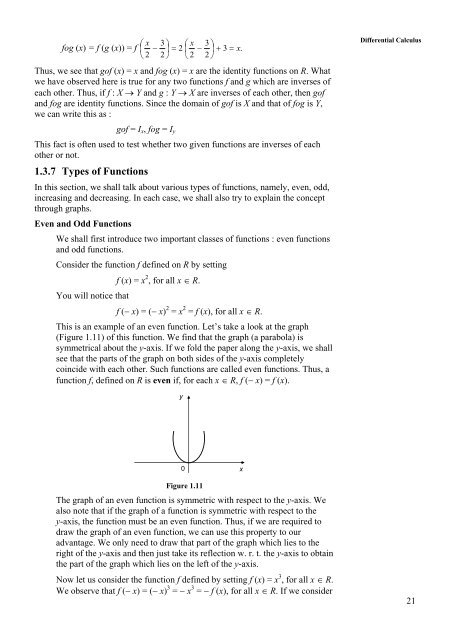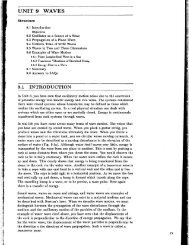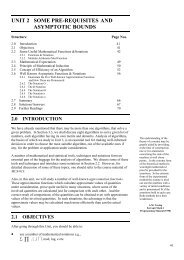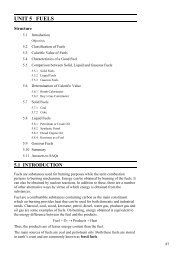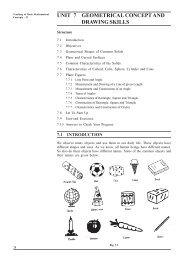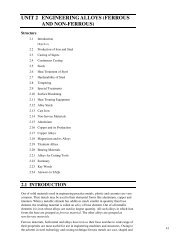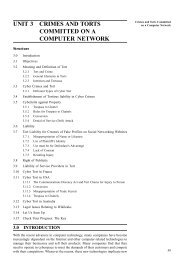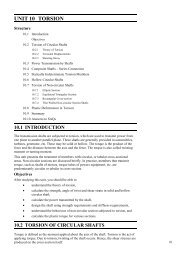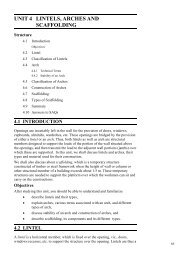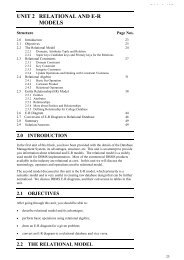unit 1 differential calculus - IGNOU
unit 1 differential calculus - IGNOU
unit 1 differential calculus - IGNOU
Create successful ePaper yourself
Turn your PDF publications into a flip-book with our unique Google optimized e-Paper software.
⎛ x 3 ⎞ ⎛ x 3 ⎞<br />
fog (x) = f (g (x)) = f ⎜ − ⎟ = 2 ⎜ − ⎟ + 3 = x.<br />
⎝ 2 2 ⎠ ⎝ 2 2 ⎠<br />
Thus, we see that gof (x) = x and fog (x) = x are the identity functions on R. What<br />
we have observed here is true for any two functions f and g which are inverses of<br />
each other. Thus, if f : X → Y and g : Y → X are inverses of each other, then gof<br />
and fog are identity functions. Since the domain of gof is X and that of fog is Y,<br />
we can write this as :<br />
gof = Ix, fog = Iy<br />
This fact is often used to test whether two given functions are inverses of each<br />
other or not.<br />
1.3.7 Types of Functions<br />
In this section, we shall talk about various types of functions, namely, even, odd,<br />
increasing and decreasing. In each case, we shall also try to explain the concept<br />
through graphs.<br />
Even and Odd Functions<br />
We shall first introduce two important classes of functions : even functions<br />
and odd functions.<br />
Consider the function f defined on R by setting<br />
You will notice that<br />
f (x) = x 2 , for all x ∈ R.<br />
f (− x) = (− x) 2 = x 2 = f (x), for all x ∈ R.<br />
This is an example of an even function. Let’s take a look at the graph<br />
(Figure 1.11) of this function. We find that the graph (a parabola) is<br />
symmetrical about the y-axis. If we fold the paper along the y-axis, we shall<br />
see that the parts of the graph on both sides of the y-axis completely<br />
coincide with each other. Such functions are called even functions. Thus, a<br />
function f, defined on R is even if, for each x ∈ R, f (− x) = f (x).<br />
y<br />
0<br />
Figure 1.11<br />
The graph of an even function is symmetric with respect to the y-axis. We<br />
also note that if the graph of a function is symmetric with respect to the<br />
y-axis, the function must be an even function. Thus, if we are required to<br />
draw the graph of an even function, we can use this property to our<br />
advantage. We only need to draw that part of the graph which lies to the<br />
right of the y-axis and then just take its reflection w. r. t. the y-axis to obtain<br />
the part of the graph which lies on the left of the y-axis.<br />
Now let us consider the function f defined by setting f (x) = x 3 , for all x ∈ R.<br />
We observe that f (− x) = (− x) 3 = − x 3 = − f (x), for all x ∈ R. If we consider<br />
x<br />
Differential Calculus<br />
21


